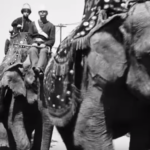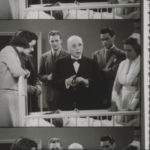NFPF Grants to Preserve 61 Films
The National Film Preservation Foundation has announced the winners of its 2022 federally funded grants. 28 institutions will use the awards to preserve 61 films or sets of films.
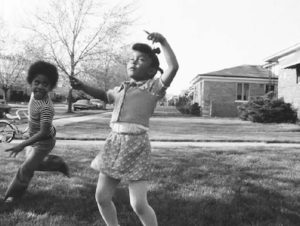
From “Aerial” by Zora Lathan. See below: National Museum of African American History and Culture. All images: National Film Preservation Foundation, except as noted.
They include the first true cowboy movie star, lecture reels of Dian Fossey’s mountain gorilla research, a short silent comedy, and much else. Also among the titles that organizations around the United States will preserve are narrative films, a silent melodrama, documentaries, home movies, and industrial and educational films.
ince its creation by Congress in 1996, the NFPF has provided preservation support to 331 institutions and saved 2,693 films through grants and collaborative projects. Funds authorized through The Library of Congress Sound Recording and Film Preservation Programs Reauthorization Act of 2016, for which the Library of Congress successful lobbied, make the grants possible along with contributions from members of the public.
The NFPF preservation grants target newsreels, silent-era films, culturally important home movies, avant-garde films, and endangered independent productions that do not attract commercial preservation programs. With the awards, organizations create a film preservation master and two access copies of each work. The saved films are used in education and exhibited through screenings, exhibits, DVDs and Blu-rays, television, and streaming. A curated selection of the preserved films is available for viewing on the NFPF website, and more than 250 additional titles have been made accessible by grant recipients.
This year, 28 institutions received awards including 8 for the first time.
Alaska Moving Image Preservation Association
Three films of elders from the Alaskan Yup’ik village of Emmonak:
Evan Hamilton Sr.: The Potlatch (ca. 1970–73), footage of a Yup’ik village elder retelling the legend of the first Yukon Delta potlatch
Francis Lee: Medicinemen of the Yukon Delta (ca. 1970–73), documentation of a Yup’ik village elder discussing the role of village shamans
Francis Lee: Whitemen and Missionaries on the Yukon Delta (ca. 1970–73), documentation of a Yup’ik village elder speaking about the first encounters between Lower Yukon native peoples and white men
American Jewish Joint Distribution Committee
Immigrants in Casablanca, Belgium and Holland Tourist Scenes (1954–56), footage of a camp for Moroccan Jews heading to Israel, filmed by the JDC Executive Vice Chairman
A Mother for Shamsi (1961), fiction short repurposed from footage of Tehran’s Jewish ghetto filmed by Mohammad Ali Issari, official cinematographer to the Shah of Iran
North Africa #1 and # 2 (early 1950s), documentation of Jewish schools and organizations supported by the JDC in Morocco and Tunisia
Refugee Children in France (1956), footage of a home used to prepare North African children for immigration to Israel
Refugees in Transit Camp in Marseilles, France (1956), footage of Jewish Egyptian refugees filmed by the AJJDC Executive Vice Chairman
Berkeley Art Museum and Pacific Film Archive
After the Earthquake/Después del Terremoto (1979), fiction short on the experiences of Nicaraguan refugees in San Francisco, made by Lourdes Portillo and Nina Serrano
Bob Mizer Foundation
Four physique modeling films by photographer Bob Mizer:
Adams & Morris (1958)
Adams & Page (1958)
Clumsy Boxer (1956)
Farmer and the Boxer (1959)
Bruce Museum
Tropical Wild Life (1957), documentation of a research field trip to Panama’s Barro Colorado Island by naturalist Paul G. Howes
Chicago Film Archives
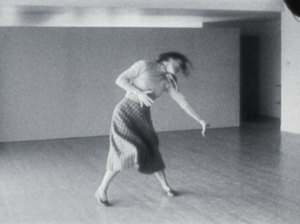
An image from Salute to Old Friends: Agnes de Mille (1956). Chicago Film Archives.
Eight films of short solo dances by maverick modern dancer Sybil Shearer:
In a Vacuum (ca. 1956), film of Shearer’s solo dance on the mechanization of the individual, first performed during her 1941 debut at Carnegie Hall
No Peace on Earth (ca. 1956), photographer Helen Morrison’s documentation of a solo dance by Shearer
O Lost (ca. 1956), photographer Helen Morrison’s documentation of Shearer’s dance celebration of individualism
Salute to Old Friends: Agnes de Mille (ca. 1956), Shearer’s solo dance tribute to a fellow dancer, set to music by the Dave Brubeck Quartet
Salute to Old Friends: Doris Humphrey (ca. 1956), Shearer’s solo dance tribute to a fellow dancer, set to music by Miles Davis
Salute to Old Friends: John Martin (ca. 1956), Shearer’s solo dance tribute to the New York Times’ dance critic, set to music by the Benny Goodman Quintet
Salute to Old Friends: Walter Terry (ca. 1956), Shearer’s solo dance tribute to the New York Herald Tribune’s dance critic, set to music by the Count Basie group
Untitled (Moussorgsky) (ca.1956), documentation of Shearer’s dance set to Mussorgsky’s “Pictures at an Exhibition”
Cranbrook Educational Community
Cranbrook Institute of Science Collection (1935–38 & 1955–60), eight educational films produced by the Institute on biology, botany, astronomy, and geology
Frameline
Chocolate Babies (1997), a dramatic feature directed by Stephen Winters on the efforts of an underground band of multi-ethnic LGBT+ activists to expose political corruption surrounding the AIDS epidemic
George Eastman Museum
The Clutch of Circumstance (1918), silent melodrama starring Corinne Griffith as an actress whose marriage is imperiled by success on Broadway
Hagley Museum and Library
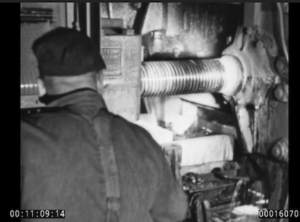
Image: Hagley Museum and Library
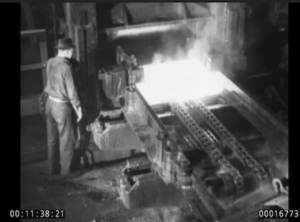 The Romance of Iron and Steel (1938), sponsored film from the American Rolling Mill Company on the process of steel production, the earliest surviving work by the still-operating Cinecraft Productions. The film follows the entire steel production process, from mining ore to the manufacturing facility to the finished product. The film is part of the Culley family collection of Cinecraft Productions and among the relatively small number of movies saved by Ray Culley, who founded Cinecraft Productions in Cleveland, Ohio, with his wife Betty in 1938. The Romance of Iron and Steel was one of the first films the newly founded company produced. It includes a striking tracking shot following a slab of molten steel through a continuous rolling mill that transforms it into a piece of sheet steel as “thin as a dime.” [Watch it online.] Hagley received the same grant last year to preserve The Heart Cleveland, also from the Cinecraft collection, but that film preceded the company’s start. The Romance of Iron and Steel is the first film produced by Cinecraft to receive support from the National Film Preservation Foundation.
The Romance of Iron and Steel (1938), sponsored film from the American Rolling Mill Company on the process of steel production, the earliest surviving work by the still-operating Cinecraft Productions. The film follows the entire steel production process, from mining ore to the manufacturing facility to the finished product. The film is part of the Culley family collection of Cinecraft Productions and among the relatively small number of movies saved by Ray Culley, who founded Cinecraft Productions in Cleveland, Ohio, with his wife Betty in 1938. The Romance of Iron and Steel was one of the first films the newly founded company produced. It includes a striking tracking shot following a slab of molten steel through a continuous rolling mill that transforms it into a piece of sheet steel as “thin as a dime.” [Watch it online.] Hagley received the same grant last year to preserve The Heart Cleveland, also from the Cinecraft collection, but that film preceded the company’s start. The Romance of Iron and Steel is the first film produced by Cinecraft to receive support from the National Film Preservation Foundation.
Hartford Public Library
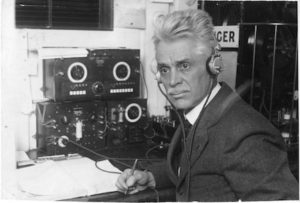
Hartford Public Library
Hiram Percy Maxim Collection (1920s–30s), 11 reels shot by the inventor, explorer, and Amateur Cinema League founder, including footage of the New England Flood of 1927 and the Maxim Silencer Company headquarters. Maxim invented the Maxim Silencer, pioneered the American Radio Relay League, and created airplane parts. He created the Columbia electric motor carriage and worked as an automobile designer and engineer until forming Maxim Silent Firearms Co. in 1908 to make Maxim silencers, which were used to suppress the sound of firearms discharging. He used the same technology to reduce noise in other arenas.
Knox County Public Library
Walter Barth Collection, Part II (1930s–70s), home movies of a German engineer’s life and travels after immigrating to the U.S.
Moore College of Art and Design
Five films documenting student work and fashion shows at Moore College, the first and only women’s art and design school in the U.S..
Drawing in School (ca. 1940s)
Fashion Drawings (ca. 1940s)
Fashion Show 1940 (No. 13) (1940)
Fashion Show 1940: Philadelphia School of Design (1940)
Interior Decor (ca. 1940s)
National Gallery of Art
David E. Finley Collection, Part III (1928–35), home movies of domestic life in Virginia and amateur theatricals by the first director of the National Gallery of Art
National Geographic Society
Dian Fossey Gorilla Lecture Film (1973), footage accompanying Fossey’s NGS lecture on her groundbreaking research into gorilla diet, vocalization, and social behavior in the Virunga mountains of East Africa, funded by National Geographic. Fossey’s work changed perceptions of gorillas and increased conservation efforts, as discussed in her 1983 book Gorillas in the Mist.
National Museum of African American History and Culture, Smithsonian Institution
Seven short films made by University of Illinois student Zora Lathan in the mid-1970s that expand the history of African American amateur filmmaking:
Aerial (ca. 1975), film portrait of children at play
American Pie (ca. 1975), animated collage
The Bump (ca. 1975), experimental student film showing Lathan’s mother with a professional dance instructor
Doberman (Beware of Dog) (ca. 1975), experimental student film
For the Love of Money (ca. 1975), animated collage
Performer’s Dressing Room (ca. 1975), student film set backstage in Chicago’s Goodman Theater
Trip Or I’m Late I’m Late (ca. 1975), abstract depiction of a journey Lathan took on Chicago’s L train
New York Public Library
If This Ain’t Heaven (1983), poetic documentary by Roberta Cantow about a middle-aged, African-American New Yorker and his cat Africa
New York University
Farewell, Etaoin Shrdlu (1981), documentary by New York Times proofreader David Loeb Weiss on the last night the newspaper was printed entirely on “hot type,” described by Walter Cronkite as “a great contribution to the documentation of an era that was the greatest in the history of newspaper publishing”
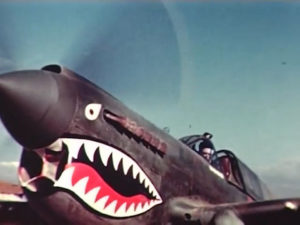
 Pan Am Historical Foundation
Pan Am Historical Foundation
Royal Leonard Film Collection (mid-1930s to early 40s): 27 reels of wartime aviation footage shot by an elite aviator during service in wartime China
Paso del Norte Community Foundation
Santa (1932), melodrama produced by El Paso–based Azteca Films and directed by Spanish-American silent star Antonio Moreno, that was one of the first Mexican features made with recorded dialogue
Pittsburgh Sound + Image
Spang’s First Century (ca. 1926), feature length sponsored film about Pittsburgh-based pipe manufacturer Spang Chalfant & Co.
Roger Tory Peterson Institute
Flamingos on Four Continents (ca. 1958), feature length documentary on all six species of flamingo by Roger Tory Peterson, author of the Field Guide to Birds
Southern Oregon Historical Society
An Equal Chance (1920), dramatized documentary produced by the National Organization for Public Health Nursing on challenges faced by medical workers during the 1918 flu epidemic
Ted Stevens Foundation
ANCSA w/ Alaska Constituents (early 1970s), filmed report to constituents by Senator Ted Stevens, concerning the Alaska Native Claims Settlement Act
Senator Ted Stevens Collection (early to mid-1960s), footage of Alaska Senator Ted Stevens’ family life and travels, including documentation of the 1964 Good Friday earthquake
Ted Stevens and Richard Nixon (1970s), footage of Alaska Senator Ted Stevens and President Nixon in Washington D.C.
UCLA Film & Television Archive
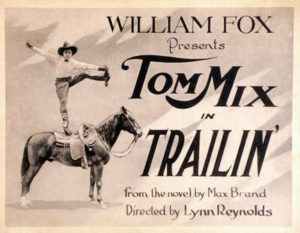 Trailin’ (1921), mystery-western about a wealthy young man who goes west to learn the truth about his parents, starring Tom Mix, the first true cowboy movie star, and Eva Novak, known for doing her own stunts. Mix plays a wealthy young man who leaves high society and heads east to find the truth of his parentage. According to Variety, the film had “an absorbing story, full of action” and was “well played by a group of western types,” including Novak, “who mounts her steed to ride to the rescue of her hero.” UCLA Film & Television Archive will preserve Trailin’ from the only surviving nitrate print
Trailin’ (1921), mystery-western about a wealthy young man who goes west to learn the truth about his parents, starring Tom Mix, the first true cowboy movie star, and Eva Novak, known for doing her own stunts. Mix plays a wealthy young man who leaves high society and heads east to find the truth of his parentage. According to Variety, the film had “an absorbing story, full of action” and was “well played by a group of western types,” including Novak, “who mounts her steed to ride to the rescue of her hero.” UCLA Film & Television Archive will preserve Trailin’ from the only surviving nitrate print
University of South Carolina, Moving Image Research Collections
England 1944 (1944), a South Carolina cotton mill–owner’s footage of the war-ravaged English textile industry
France 1944 (1944), a South Carolina cotton mill–owner’s footage of the war-ravaged French textile industry
Spartan Mill as a Community (ca. 1938), footage of a South Carolina cotton mill town, shot by mill owner Walter S. Montgomery
USS Hornet Sea, Air and Space Museum
Apollo 11 Recovery Mission (1969), amateur footage by a USS Hornet crewman documenting the recovery of the module from the first spaceflight to land humans on the moon
Norton Home Movies (1948–50), home movies by a captain on the USS Hornet aircraft carrier of aircraft operations and launches
Training for Apollo 12 (1969), footage of mission crew’s spacecraft exit training in the Gulf of Mexico
Yale Film Archive

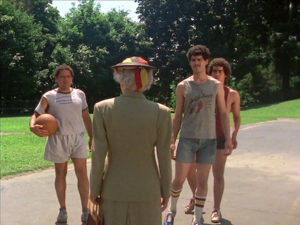 The Cruz Brothers and Miss Malloy (1980), short comedic feature by Kathleen Collins about three Puerto Rican brothers hired to renovate the home of an elderly Irish widow in New York. The film is one of two that filmmaker/professor Kathleen Collins completed before her premature death from cancer. “Losing Ground (1982), the second and final film by Kathleen Collins, was added to the National Film Registry in 2020.” In a media release, Allyson Nadia Field, associate professor of cinema and media studies at the University of Chicago, a member of the National Film Preservation Board and the panel that reviewed this year’s proposals, said that preserving The Cruz Brothers and Miss Malloy “safeguards the legacy of a pioneering African-American filmmaker.” While Collins was teaching film history and screenwriting at the City College of New York, one of her students inspired her to direct a movie. Her unlikely comedy, set in New York’s Rockland County, depicts three young Puerto Rican men, the ghost of their father, and an elderly Irish widow whose house requires restoration for a mysterious purpose.
The Cruz Brothers and Miss Malloy (1980), short comedic feature by Kathleen Collins about three Puerto Rican brothers hired to renovate the home of an elderly Irish widow in New York. The film is one of two that filmmaker/professor Kathleen Collins completed before her premature death from cancer. “Losing Ground (1982), the second and final film by Kathleen Collins, was added to the National Film Registry in 2020.” In a media release, Allyson Nadia Field, associate professor of cinema and media studies at the University of Chicago, a member of the National Film Preservation Board and the panel that reviewed this year’s proposals, said that preserving The Cruz Brothers and Miss Malloy “safeguards the legacy of a pioneering African-American filmmaker.” While Collins was teaching film history and screenwriting at the City College of New York, one of her students inspired her to direct a movie. Her unlikely comedy, set in New York’s Rockland County, depicts three young Puerto Rican men, the ghost of their father, and an elderly Irish widow whose house requires restoration for a mysterious purpose.
— from media releases
Previous Post: What the Self-Defense of Black Residents of Natchez Looked Like
Next Post: A Handbook for the Home Movie



